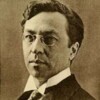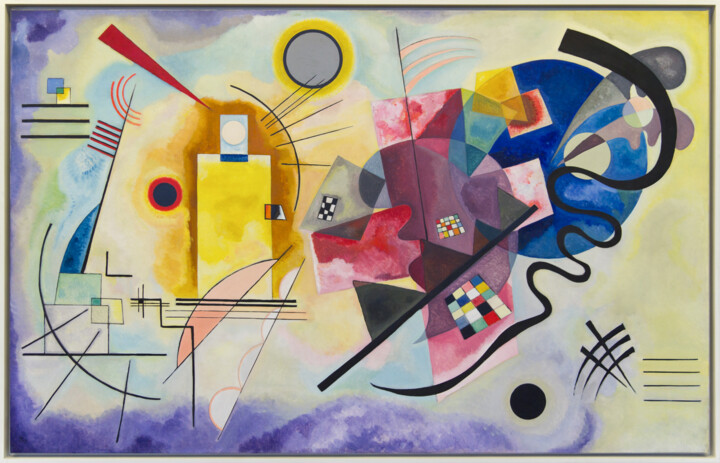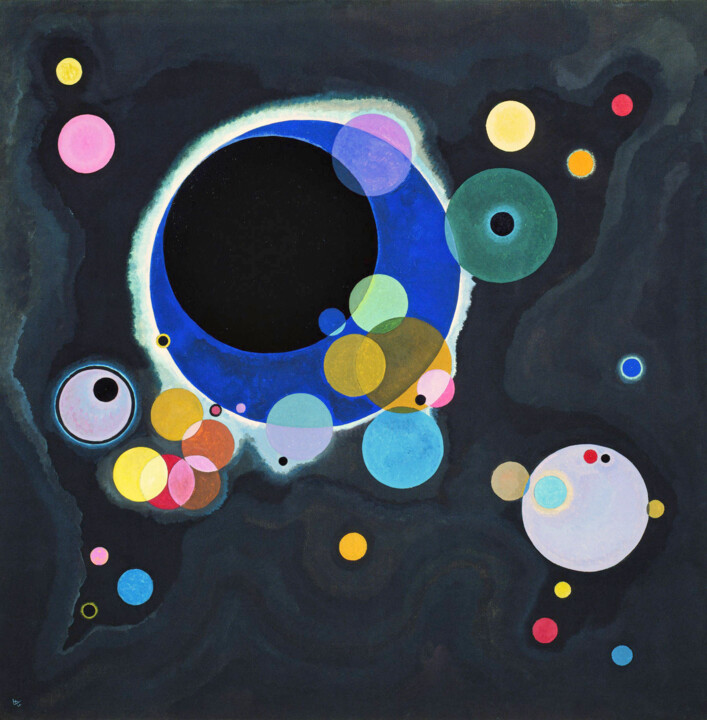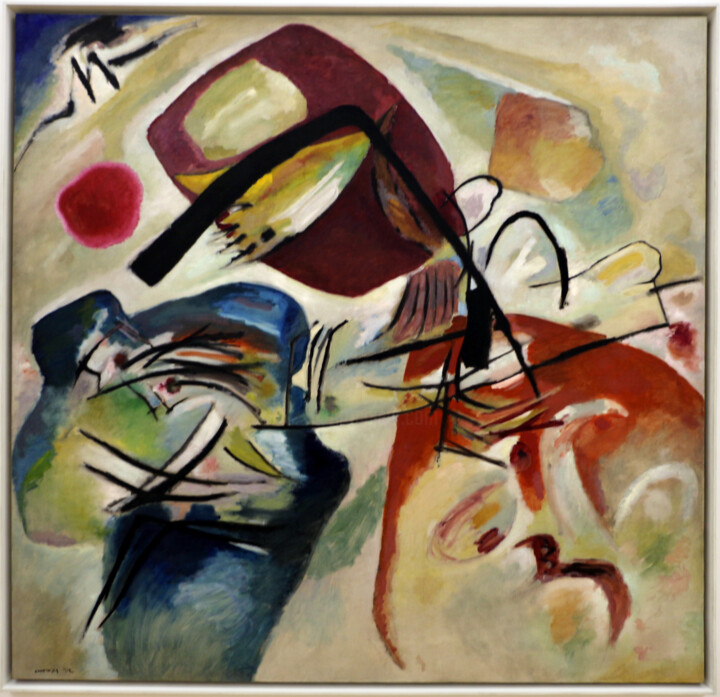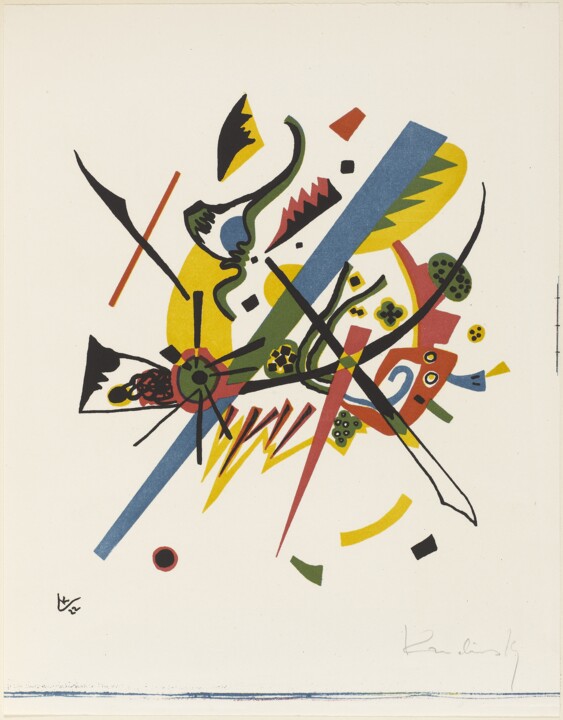 Wassily Kandinsky
Wassily Kandinsky
Who was Wassily Kandinsky?
Wassily Wassilyevich Kandinsky (1866-1944) was a Russian painter and art theorist who is widely regarded as one of the pioneers of abstract art. Born in Moscow, Kandinsky began his artistic career studying law and economics before turning to art in his thirties.
He moved to Munich, Germany, in 1896 to study art, and he enrolled in the private art school of Anton Ažbe. He later studied at the Academy of Fine Arts in Munich, where he was influenced by the Impressionist and Post-Impressionist movements, and became a leading figure in the development of avant-garde art movements such as Expressionism and Der Blaue Reiter (The Blue Rider).
Kandinsky's early paintings were influenced by his interest in spirituality and theosophy, and they featured bold colors and abstract forms that conveyed deep emotional and spiritual ideas. During his time with the Blue Rider movement, Kandinsky developed his own unique style of abstract art, characterized by his use of geometric shapes, vivid colors, and dynamic compositions.
In the 1920s, Kandinsky returned to Russia and became involved in the development of the Russian avant-garde. He taught at the Moscow Academy of Fine Arts and helped to establish the Institute of Artistic Culture in Moscow. However, he eventually left Russia in 1933 due to political pressures and moved to France, where he spent the rest of his life.
Throughout his career, Kandinsky was also deeply engaged with art theory and wrote extensively on the spiritual and emotional dimensions of art. His book "Concerning the Spiritual in Art," published in 1910, is considered a seminal work in the development of modern art theory.
Kandinsky's works are renowned for their use of color, form, and composition to convey deep emotional and spiritual ideas. His paintings continue to be widely exhibited and collected around the world, and they are an important part of the modern art canon.
 Wassily Kandinsky - Composition IX, 1936. Oil on canvas. Musée National d'Art Moderne, Paris
Wassily Kandinsky - Composition IX, 1936. Oil on canvas. Musée National d'Art Moderne, Paris
Kandinsky's artistic periods
Wassily Kandinsky's artistic career can be divided into several distinct periods, each characterized by different styles, themes, and influences. They reflect his ongoing exploration of the relationship between spirituality, emotion, and abstraction in art, and his innovative contributions to the development of modernist painting.
Early period (1890s-1908): During this time, Kandinsky's work was figurative and representational, with influences from the Impressionist and Post-Impressionist movements. His early paintings often depicted landscapes and scenes from daily life, but he began to experiment with abstraction in the early 1900s. His first abstract works were still influenced by his earlier style and were often based on landscapes or natural forms.
One of Kandinsky's earliest works, painted in 1901, is called "Akhtyrka" and depicts a small town in Russia. The painting shows Kandinsky's interest in capturing the atmosphere and mood of a place through color and brushwork.
"Murnau with Church II" (1910) is a good example of Kandinsky's early style, which was influenced by the Fauvist movement and Expressionism. It is also an important work in the development of abstract art, as Kandinsky began to move away from representational painting and towards more abstract forms shortly after creating this piece.
Kandinsky's early period was a time of experimentation and exploration, as he sought to develop his own unique artistic style. While his early works are often less well-known than his later abstract pieces, they are still important in understanding the evolution of his artistic vision.
 Wassily Kandinsky - Akhtyrka, 1901. Oil on canvas. Lenbachhaus, München, Germany
Wassily Kandinsky - Akhtyrka, 1901. Oil on canvas. Lenbachhaus, München, Germany
Expressionist period (1908-1914): This period refers to the time in his artistic career when he was heavily influenced by the Expressionist movement. Kandinsky's work became increasingly abstract during this period, with an emphasis on color and expression. His paintings were characterized by bold, vibrant colors and dynamic compositions.
One of Kandinsky's most famous works from his Expressionist period is "Composition VII," which he painted in 1913. This painting is characterized by its use of bold colors and abstract forms, and it is often cited as a prime example of non-representational art.
Other works from Kandinsky's Expressionist period include "Improvisation 28" (1912) and "Blue Mountain" (1908-1909). These works, like "Composition VII," feature bold colors and abstract forms that suggest emotional and spiritual themes.
Kandinsky's Expressionism period was a time of intense experimentation and exploration, as he sought to convey powerful emotions through his art. While his later abstract works are perhaps better known, this period played an important role in the development of his artistic vision.
During this time, Kandinsky was living in Munich and was part of a group of artists known as the Blue Rider. The Blue Rider movement was an influential group of artists that was active in Germany in the early 20th century. The group was founded in 1911 by Wassily Kandinsky and Franz Marc, and it was dedicated to exploring new forms of expression in art.
The artists associated with the Blue Rider movement were interested in a wide range of artistic styles and techniques, including Fauvism, Expressionism, and abstract art. They were also interested in exploring the spiritual and emotional dimensions of art, and many of their works were characterized by bold colors and abstract forms.
Some of the most famous artists associated with the Blue Rider movement, in addition to Wassily Kandinsky and Franz Marc, include August Macke, Paul Klee, Alexej von Jawlensky, Lyonel Feininger and Gabriele Münter. These artists were all united in their belief that art had the power to transform the world, and they sought to create works that would inspire viewers and provoke new ways of thinking.
The Blue Rider movement was short-lived, lasting only a few years before it was disrupted by the outbreak of World War I. Nevertheless, the movement had a profound influence on the development of modern art, and it paved the way for many of the artistic movements that would emerge in the decades that followed.
 Wassily Kandinsky - Composition VII, 1913. Oil on canvas. Tretyakov Gallery, Moscow
Wassily Kandinsky - Composition VII, 1913. Oil on canvas. Tretyakov Gallery, Moscow
Russian period (1914-1921): Kandinsky returned to Russia during World War I and became involved in the country's avant-garde art scene. This period was marked by a renewed interest in Russian folk art and a greater focus on geometric abstraction.
During this time, Kandinsky became involved with a number of artistic groups and movements, including the Jack of Diamonds group and the Suprematist movement. He was also involved in the establishment of the Institute of Artistic Culture in Moscow, which was dedicated to promoting new forms of art and design.
One of Kandinsky's most famous works from his Russian period is "Composition VIII," which he painted in 1923. This painting is characterized by its use of geometric forms and bold colors, and it is often cited as a prime example of Suprematist art.
Other works from Kandinsky's Russian period include "Black and Violet" (1923) and "Circles in a Circle" (1923). These works reflect Kandinsky's interest in the use of geometric shapes and colors to express spiritual and emotional themes.
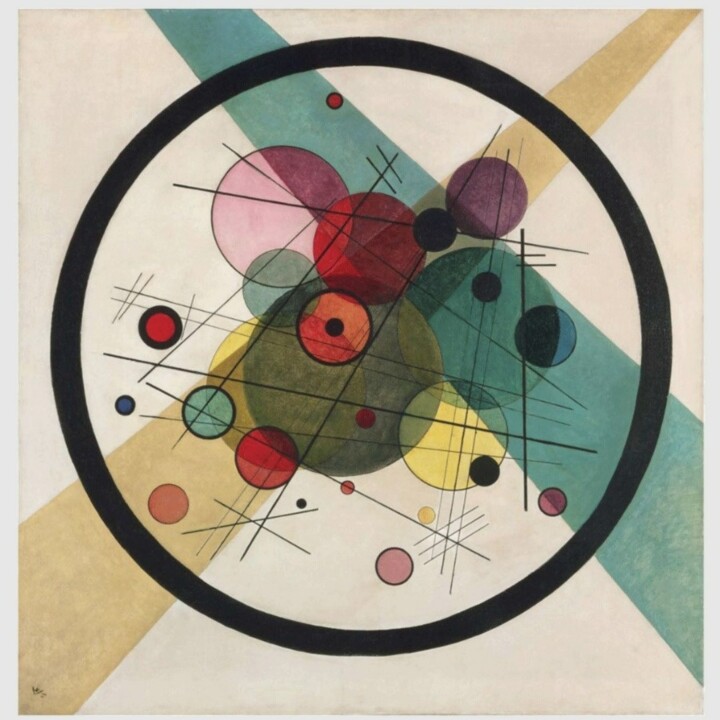 Wassily Kandinsky - Circles in a Circle, 1923. Oil on canvas. Philadelphia Museum of Art, Philadelphia, USA
Wassily Kandinsky - Circles in a Circle, 1923. Oil on canvas. Philadelphia Museum of Art, Philadelphia, USA
Bauhaus period (1922-1933): Kandinsky's Bauhaus period refers to the time in his artistic career when he was associated with the Bauhaus school of art and design in Germany. This period was marked by a focus on geometric abstraction and the integration of art and technology.
Kandinsky joined the faculty of the Bauhaus in 1922, and he quickly became a prominent figure within the school. He taught a number of courses on color theory and abstract art, and he also served as the director of the mural painting workshop.
During his time at the Bauhaus, Kandinsky continued to explore the use of geometric shapes and bold colors in his artwork. He also became interested in the potential of art to create social change, and he developed a theory of art that he called "the spiritual in art."
Kandinsky's most famous work from his Bauhaus period is "Yellow-Red-Blue" (1925). This work reflects Kandinsky's interest in the use of geometric shapes and colors to express spiritual and emotional themes.
In addition to his artistic work, Kandinsky also played an important role in the development of the Bauhaus as an institution. He helped to shape the curriculum and the philosophy of the school, and he worked to promote the integration of art and technology.
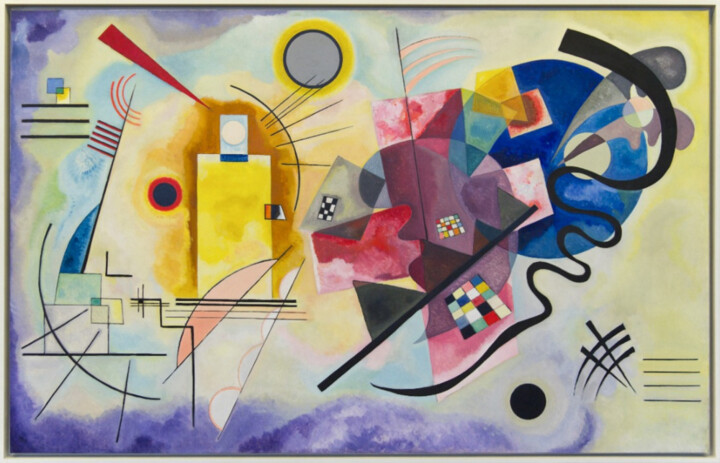 Wassily Kandinsky - Yellow-Red-Blue, 1925. Oil on canvas. Musée National d'Art Moderne, Paris
Wassily Kandinsky - Yellow-Red-Blue, 1925. Oil on canvas. Musée National d'Art Moderne, Paris
Paris period (1933-1944): Kandinsky moved to Paris in 1933 and continued to paint and write until his death in 1944. During this period, Kandinsky continued to explore the use of geometric shapes and bold colors in his artwork, but his style also underwent some significant changes.
In Paris, Kandinsky became associated with a group of artists known as the Abstraction-Création group, which was dedicated to the promotion of abstract art. Kandinsky also began to incorporate more organic forms into his work, reflecting his interest in the natural world.
Some of Kandinsky's most famous works from his Paris period include "Sky Blue" (1940), and “Composition X” (1939). These works reflect Kandinsky's continued interest in the use of color and form to express spiritual and emotional themes, but they also demonstrate his growing interest in the natural world and the rhythms of the universe. During his time in Paris, Kandinsky also continued to write and publish on the subject of art and its relationship to spirituality.
 Wassily Kandinsky - X, 1939. Oil on canvas. Kunstsammlung Nordrhein-Westfalen, Düsseldorf
Wassily Kandinsky - X, 1939. Oil on canvas. Kunstsammlung Nordrhein-Westfalen, Düsseldorf
Theoretical writings
Wassily Kandinsky was not only an accomplished artist, but he was also a significant art theorist. He believed that art had the potential to express the spiritual and emotional dimensions of human experience, and he sought to develop a theory of art that reflected this belief. His book "Point and Line to Plane" (1926) is still considered a seminal work on the subject of abstract art.
One of Kandinsky's most famous art theories is his idea of "the spiritual in art." According to Kandinsky, art has the ability to awaken the viewer's inner emotions and spirituality. He believed that the colors and forms used in an artwork could communicate these emotions and spiritual ideas directly to the viewer, bypassing the need for verbal or written language.
His book "Concerning the Spiritual in Art" (1911) explored the spiritual dimension of art and its potential to transcend materialism. Kandinsky argued that art should be free from representational constraints and that color and form could be used to express emotions and ideas in their own right. He also believed that abstract art was the purest form of artistic expression, and his ideas had a significant influence on the development of modern art. Kandinsky's writings on art continue to be studied and analyzed by art historians and theorists today.
Another important art theory developed by Kandinsky was his idea of "synesthesia." Kandinsky believed that colors, shapes, and sounds were all interconnected, and that they could be used in art to evoke complex emotional and spiritual responses. He believed that the use of color and form in an artwork could create a kind of "music for the eyes," in which the viewer would experience a sensory and emotional response to the artwork.
Kandinsky also believed that abstract art was the highest form of art, as it allowed for the most direct expression of the artist's inner emotions and spiritual ideas. He saw abstract art as a kind of universal language that could be understood by people of all cultures and backgrounds.
5 Most Famous Paintings by Wassily Kandinsky
"Composition VII" (1913): This is one of Kandinsky's most famous works and is known for its vibrant colors and complex composition. The painting features a series of overlapping geometric shapes that create a sense of movement and energy.
"Yellow-Red-Blue" (1925): Kandinsky believed that color had a spiritual quality and could convey emotions and ideas in a way that was more direct than representational art. In "Yellow-Red-Blue", the use of color is meant to convey a sense of spiritual harmony and balance.
"Composition VIII" (1923): The painting is considered an important work in the development of abstract art and is admired for its use of color and form to create a sense of movement. It is also notable for its influence on later artists, including the Abstract Expressionists.
"Black and White" (1919): This artwork represents Kandinsky's exploration of the expressive potential of black and white. The forms are simplified and abstract, but still suggest a sense of depth and dimensionality. In "Black and White", the use of contrasting colors is meant to create a sense of tension and balance, while the simplified forms are meant to convey a sense of spirituality and transcendence.
"Blue Mountain" (1908-1909): It is considered an early example of Kandinsky's exploration of abstraction and the expressive potential of color and form. It is also an example of the influence of Russian folk art on Kandinsky's work, as the simplified form of the mountain is reminiscent of the stylized forms found in traditional Russian art.
 Wassily Kandinsky - Blue mountain, 1908-1909. Oil on canvas. Solomon R. Guggenheim Museum
Wassily Kandinsky - Blue mountain, 1908-1909. Oil on canvas. Solomon R. Guggenheim Museum
Art market and museums
Wassily Kandinsky's works have long been highly sought after in the art market, and they continue to command significant prices at auction. Some of Kandinsky's most famous works, such as "Studie für Improvisation 8," "Fugue," and "Rigide et Courbé," have sold for millions of dollars at Christie's and Sotheby's auctions in recent years. These works are highly valued for their historical significance, artistic innovation, and expressive power.
Kandinsky's works are particularly sought after by collectors who are interested in the development of abstract art and the history of modern art. However, not all of Kandinsky's paintings command such high prices at auction. Smaller works or those with less provenance or historical significance may sell for tens or hundreds of thousands of dollars, rather than millions.
Many of Kandinsky's most famous paintings are held in major museum collections, such as the Solomon R. Guggenheim Museum in New York, the Museum of Modern Art in New York, and the Centre Georges Pompidou in Paris. These institutions frequently exhibit Kandinsky's works as part of their permanent collections or special exhibitions.
Kandinsky's works are also featured in many other museums and galleries around the world, including the Art Institute of Chicago, the Tate Modern in London, and the Hermitage Museum in St. Petersburg.
In addition to his paintings, Kandinsky's writings and theoretical works are also held in museum collections, and they are often studied and exhibited alongside his artwork. These writings offer important insights into Kandinsky's artistic vision and his ideas about the spiritual and emotional power of abstract art.

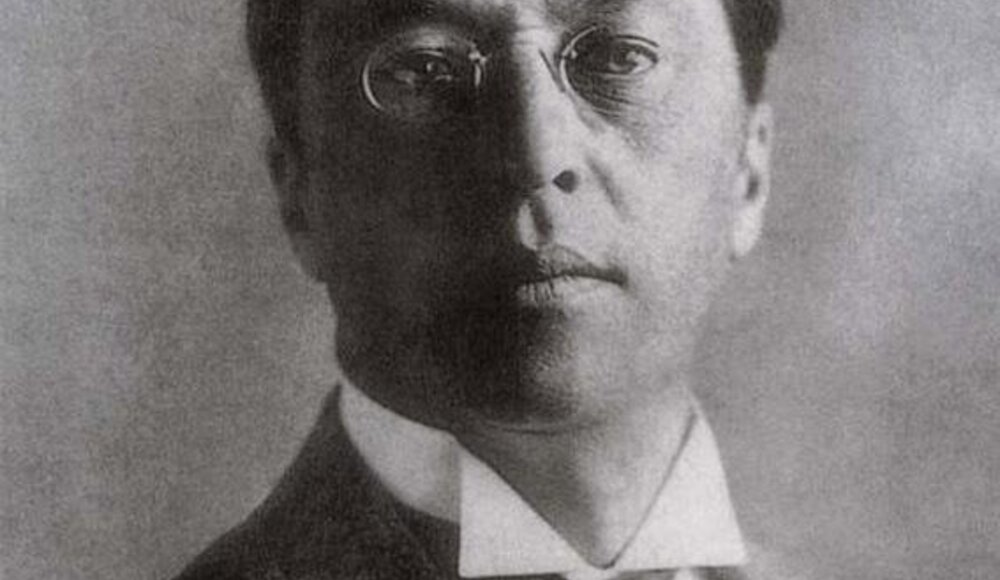
 Selena Mattei
Selena Mattei
